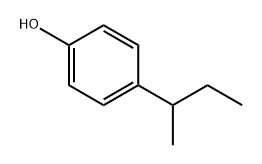Chemical Properties
The butylphenols include several isomers.
Solid butylphenols (28805-86-9) generally have properties
similar to the above:
Uses
Phenolic Resins, Epoxy Resins
Definition
ChEBI: 4-sec-Butylphenol is an alkylbenzene.
Safety Profile
Poison by intravenous
and intraperitoneal routes. Moderately toxic
by ingestion. Combustible when exposed to
heat or flame. When heated to
decomposition it emits toxic fumes. To fight
fire, use foam, CO2, dry chemical.
Incompatible with oxidizing materials. See
also PHENOL and other butyl phenols.
Potential Exposure
Butylphenols may be used as intermediates in manufacturing varnish and lacquer resins; as a
germicidal agent in detergent disinfectants; as a pour point
depressant, in motor-oil additives; de-emulsifier for oil;
soap-antioxidant, plasticizer, fumigant, and insecticide
Shipping
UN2430 Alkylphenols, solid, n.o.s. (including
C2-C12 homologues), Hazard class: 8; Labels: 8—
Corrosive material
Incompatibilities
Vapors may form explosive mixture with
air. These phenol/cresol materials can react with oxidizers;
reaction may be violent. Incompatible with strong reducing
substances such as hydrides, nitrides, alkali metals, and sulfides. Flammable gas (H2) is often generated, and the heat
of the reaction may cause the gas to ignite and explode.
Heat is also generated by the acid-base reaction with bases;
such heating may initiate polymerization of the organic
compound. React with boranes, alkalies, aliphatic amines,
amides, nitric acid, sulfuric acid. Phenols are sulfonated
very readily (for example, by concentrated sulfuric acid at
room temperature). These reactions generate heat. Phenols
are also nitrated very rapidly, even by dilute nitric acid and
can explode when heated. Many phenols form metal salts
that may be detonated by mild shock





